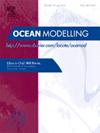Upper ocean biophysical budget analysis during a cyclone using Regional Ocean Modeling System
IF 2.9
3区 地球科学
Q2 METEOROLOGY & ATMOSPHERIC SCIENCES
引用次数: 0
Abstract
The biophysical response of upper ocean during the passage of the very severe cyclonic storm ‘Titli’ over Bay of Bengal (BoB) during October 2018 is studied using the Regional Ocean Modeling System coupled with nutrient-phytoplankton-zooplankton-detritus (ROMS-NPZD) framework. Assessments with satellite and Argo observations show that the model forced by Scatsat-I winds and reanalysis fluxes simulates the changes in the upper ocean reasonably well. The biophysical variability is significantly realized in a cyclone-induced open-ocean upwelling region underlying the peak intensity of the cyclone. After the passage of the cyclone, surface chlorophyll-a concentration increases tenfold in the upwelling region. This increase of simulated surface phytoplankton further enhances the surface dissolved oxygen concentration by ∼10μM from an initial value of 200μM. Strong temporal correspondences between the depth of the thermocline () and the oxycline (r = 0.97) and between nutricline and the mixed-layer depth (MLD) (r = 0.52) are also observed. A detailed term-by-term biophysical budget analysis is carried out with temporal tendency of temperature (and other biophysical parameters) subdivided into various components: (i) net surface heat (or buoyancy) flux; (ii) horizontal advection; (iii) vertical entrainment; (iv) vertical mixing; and (v) source and sink terms as necessary. Results show the cooling of upper layer temperature during cyclone is due to vertical processes (entrainment and mixing), which is recovered in the post-cyclone period due to MLD advection affecting entrainment and vertical mixing, followed by restoration of net surface heat flux. The increase in salinity during the cyclone is due to MLD tendency dominating vertical entrainment process, and the post-cyclone recovery is due to the horizontal advection and net surface freshwater flux. The shoaling of the nutricline allows for the transport of the nutrients from the deeper layers to the euphotic zone and enhancement of phytoplankton concentration at the surface about five days after the cyclone interaction. Budget analysis for biological processes showed the changes in the phytoplankton concentration are associated with (i) nitrate uptake by phytoplankton and (ii) zooplankton grazing on phytoplankton. This assessment of the state-of-the-art coupled ROMS-NPZD model emphasizes its applicability for various other applications on marine ecosystem modeling.
利用区域海洋模拟系统分析气旋过程中上层海洋生物物理收支
利用区域海洋模拟系统耦合营养物-浮游植物-浮游动物-碎屑(ROMS-NPZD)框架,研究了2018年10月孟加拉湾(BoB)超强气旋风暴“Titli”通过期间上层海洋的生物物理响应。利用卫星和Argo观测进行的评估表明,由scatsat - 1风和再分析通量强迫的模式相当好地模拟了上层海洋的变化。生物物理变异性在气旋峰值强度下的气旋诱发的公海上升流区得到了显著体现。气旋通过后,上升流区地表叶绿素-a浓度增加了10倍。模拟表层浮游植物的增加使表层溶解氧浓度从初始值200μM进一步提高了约10μM。温跃层深度(D23°C)与氧跃层深度(r = 0.97)以及营养线与混合层深度(r = 0.52)在时间上也有很强的对应关系。详细的逐期生物物理预算分析将温度(和其他生物物理参数)的时间趋势细分为不同的组成部分:(i)地表净热(或浮力)通量;(ii)水平平流;(iii)垂直夹带;(四)垂直混合;(v)必要时的源汇项。结果表明:气旋期间上层温度的降温主要是由于垂直过程(夹带和混合),气旋后由于MLD平流对夹带和垂直混合的影响,上层温度的降温得到恢复,随后表层净热通量恢复。气旋期间盐度的增加是由于MLD趋势主导垂直夹带过程,气旋后的恢复是由于水平平流和净地表淡水通量。在气旋相互作用后约5天,营养线的浅滩化使营养物从较深的层运输到光区,并增强了表层浮游植物的浓度。生物过程的预算分析表明,浮游植物浓度的变化与(i)浮游植物对硝酸盐的吸收和(ii)浮游动物对浮游植物的放牧有关。对最先进的耦合ROMS-NPZD模型的评估强调了其在海洋生态系统建模中的各种其他应用的适用性。
本文章由计算机程序翻译,如有差异,请以英文原文为准。
求助全文
约1分钟内获得全文
求助全文
来源期刊

Ocean Modelling
地学-海洋学
CiteScore
5.50
自引率
9.40%
发文量
86
审稿时长
19.6 weeks
期刊介绍:
The main objective of Ocean Modelling is to provide rapid communication between those interested in ocean modelling, whether through direct observation, or through analytical, numerical or laboratory models, and including interactions between physical and biogeochemical or biological phenomena. Because of the intimate links between ocean and atmosphere, involvement of scientists interested in influences of either medium on the other is welcome. The journal has a wide scope and includes ocean-atmosphere interaction in various forms as well as pure ocean results. In addition to primary peer-reviewed papers, the journal provides review papers, preliminary communications, and discussions.
 求助内容:
求助内容: 应助结果提醒方式:
应助结果提醒方式:


